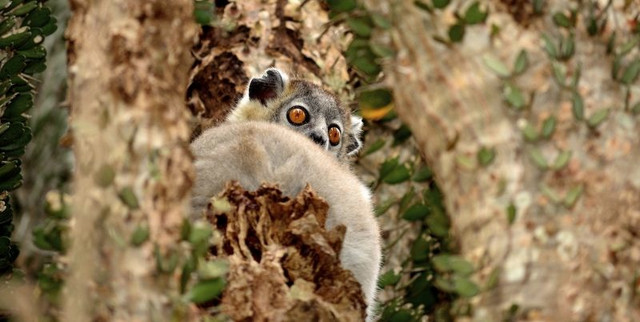Sportive lemurs stay individualists in relationships
Iris Dröscher and Peter Kappeler of the German Primate Center (DPZ) in Göttingen/Germany reported a lack of social interactions in a pair-living primates based on their field research in Madagascar. White-footed sportive lemurs live together in pairs in a shared territory, but they actively avoid each other and were never observed to interact affiliatively. This kind of social structure has not yet been described for any other primate species.
During a one-year field study in Southern Madagascar the two researchers discovered that nocturnal white-footed sportive lemurs (Lepilemur leucopus) share a common territory with a pair partner of the opposite sex. This result clarified conflicting earlier reports on the social organization of this species. The study of the DPZ researchers also revealed a specific type of relationship model that has not yet been described for other pair-living species. Although males and females live together also outside the brief annual mating season and defend a common territory together, they were never observed to huddle or to groom each other during the more than 1,500 hours of observation. "This species is characterized by an active avoidance of pair partners," says Iris Dröscher, first author and PhD student at the Behavioral Ecology and Sociobiology Unit of the DPZ.
For their research the scientists observed a population of white-footed sportive lemurs at the Berenty Reserve and followed their movements via radio collars. They found that social interaction between couples are limited to mating once a year. "For primates, grooming is an important social interaction that strengthens the relationship between individuals. But it does not exist in white-footed sportive lemur couples," explains Iris Dröscher. "Even for sleeping, the partners choose separate trees and never spend any time together." The most elaborate social interactions of white-footed sportive lemur pair partners consist of just sitting next to each other at a small distance.
As interactions with many individuals in different contexts create cognitive challenges for animals, social complexity is regarded as an essential motor for the evolution of intelligence in primates. "White-footed sportive lemurs are characterized by a minimum of social complexity; they really define the baseline among primates", says principle investigator Peter Kappeler.
Possible explanations for why sportive lemurs are pair-living at all are currently being explored: Perhaps males can monopolize at least one female for themselves that way. Alternatively, males may stay in the vicinity of their offspring to protect them from infanticidal rivals.
Original publication: Iris Dröscher & Peter K. Kappeler (2013): Defining the low end of primate social complexity: The social organization of the nocturnal white-footed sportive lemur (Lepilemur leucopus). International Journal of Primatology. doi: 10.1007/s10764-013-9735-3.
Contact
Prof. Dr. Peter M. Kappeler
Tel: +49 551 3851-376
E-Mail: pkappel(at)gwdg.de
Astrid Slizewski (public relations department)
Tel: +49 551 3851-359
E-Mail: aslizewski(at)dpz.eu




